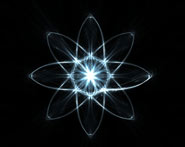


 الفيزياء الكلاسيكية
الفيزياء الكلاسيكية
 الكهربائية والمغناطيسية
الكهربائية والمغناطيسية
 علم البصريات
علم البصريات
 الفيزياء الحديثة
الفيزياء الحديثة
 النظرية النسبية
النظرية النسبية
 الفيزياء النووية
الفيزياء النووية
 فيزياء الحالة الصلبة
فيزياء الحالة الصلبة
 الليزر
الليزر
 علم الفلك
علم الفلك
 المجموعة الشمسية
المجموعة الشمسية
 الطاقة البديلة
الطاقة البديلة
 الفيزياء والعلوم الأخرى
الفيزياء والعلوم الأخرى
 مواضيع عامة في الفيزياء
مواضيع عامة في الفيزياء|
Read More
Date: 1-11-2016
Date: 26-10-2016
Date: 1-11-2016
|
Stationary States
In the Bohr model of the hydrogen atom, the angular momentum for the orbital motion of the electron of mass m at distance r is quantized in integral units of Planck’s constant h that is, assuming the proton position to be fixed, mvr = nh/2π, where n is an integer and v the electron velocity. Using mv = h/λ, de Broglie was able to derive Bohr’s quantization rule and nλ = 2πr. If f1 and f2 are the frequencies of the Bohr orbital motion of the electron in energy states E1 and E2, then if an electron jumps down from state 2 to state 1, why isn’t the energy of the emitted photon the difference energy hf1 – hf2?
Answer
In the Bohr model of the hydrogen atom, one would calculate the frequency f = 2πr/v of the electron’s orbital motion. The virial theorem states that twice the kinetic energy plus the potential energy add to zero, so mv2 = ke2 r, from which the electron’s frequency of orbit is f = n3h3/(4π2me4). The actual Bohr energy E = –2π2me4/(n2h2) is clearly a different quantity, and for an electron jump between two energy states, E2 – E1 ≠ hf2 – hf1.



|
|
|
|
دليل التغذية الأولى للرضيع.. ماذا أنسب طعام بعد 6 شهور؟
|
|
|
|
|
|
|
ماذا نعرف عن الطائرة الأميركية المحطمة CRJ-700؟
|
|
|
|
|
|
|
الأمين العام للعتبة العلوية المقدسة يستقبل المتولّي الشرعي للعتبة الرضوية المطهّرة والوفد المرافق له
|
|
|